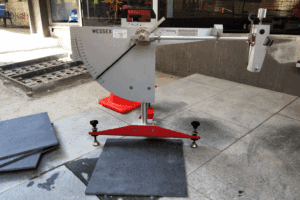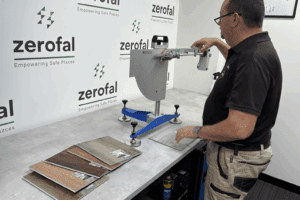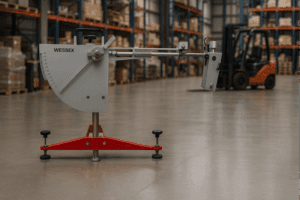Proactive vs Reactive Safety: What It Signals to Insurers
- Insurers look closely at how slips, trips and falls are managed.
- Proactive slip testing under AS 4663:2013 mitigates risk and strengthens defensibility.
- Testing only after incidents signals weak governance and raises liability exposure.
Slips, trips and falls remain one of the leading causes of serious injury claims in Australia. Insurers know this, and they treat these incidents as both predictable and preventable. The way an organisation manages floor safety – either proactively or reactively – is not just a matter of compliance. It directly shapes premiums, liability exposure, and brand reputation.
Why Insurers Care About Slips, Trips and Falls
According to Safe Work Australia, slips, trips and falls account for more than one in five serious workers’ compensation claims. These claims cost tens of thousands of dollars on average when medical costs, compensation, and lost time are taken into account. Insurers factor in this data when assessing risk. Just as importantly, they examine whether an organisation is actively monitoring and controlling the hazard, or waiting until incidents occur before acting.
Proactive Safety
A proactive approach to safety demonstrates maturity. It includes routine slip resistance testing under AS 4663:2013, documentation of compliance against the National Construction Code, and reference to guidance in HB198:2014. Organisations that identify risks early and remediate before an incident demonstrate strong governance. For insurers, this generally translates to lower premiums and more defensible positions if a claim arises.
Reactive Safety
By contrast, a reactive approach leaves surfaces untested for months or years, with problems often discovered only after a fall has occurred. This pattern tells insurers that safety is not embedded into operations. Premiums increase, claims are harder to defend, and liability exposure rises.
Managing Risk in Practice
The contrast between proactive and reactive approaches to slip resistance testing is significant. Organisations that implement regular testing cycles across pedestrian surfaces and maintain clear records of compliance can demonstrate alignment with AS 4663:2013 and HB198:2014. In the event of an incident, this evidence framework strengthens their position and often reduces liability exposure. By contrast, organisations that commission testing only after an incident are seen as reactive. This lack of ongoing documentation can undermine insurer confidence, lead to higher premiums, and increase the likelihood of adverse claim outcomes.
Best Practice
The lesson is simple: routine testing is cheaper than a single serious claim. High-traffic areas such as foyers, lobbies and food courts should be tested annually. Kitchens, entries and other high-risk wet areas such as amenities and carparks, often require shorter intervals. A centralised register of results provides defensibility in audits and insurance reviews.
Insurers are pragmatic. They know slips, trips and falls will never be eliminated, but they want evidence that risks are controlled and monitored. A proactive testing program shows diligence and reduces exposure. A reactive approach invites scrutiny.
Protect your business from unnecessary claims and premium hikes
Book proactive slip testing with Zerofal – certified under AS 4663-2013 and fully NATA-accredited.
Explore more

Colour, Grit and Surface Finish: How Subtle Differences Change Slip Ratings (AS 4586:2013)
Colour, grit and finish change slip resistance. Learn why P-ratings vary across tile ranges and coatings

Why One Slip Test Isn’t Enough for Product Lines (AS 4586:2013)
Slip resistance varies across colours and finishes. Learn why one AS 4586 test cannot certify an entire product line.

Industrial Slip Resistance: Dust, Boots & Coating Drift (AS 4663:2013)
: Industrial floors change fast. Learn how dust, coatings and machinery reduce slip resistance and why AS 4663 onsite testing is essential.
